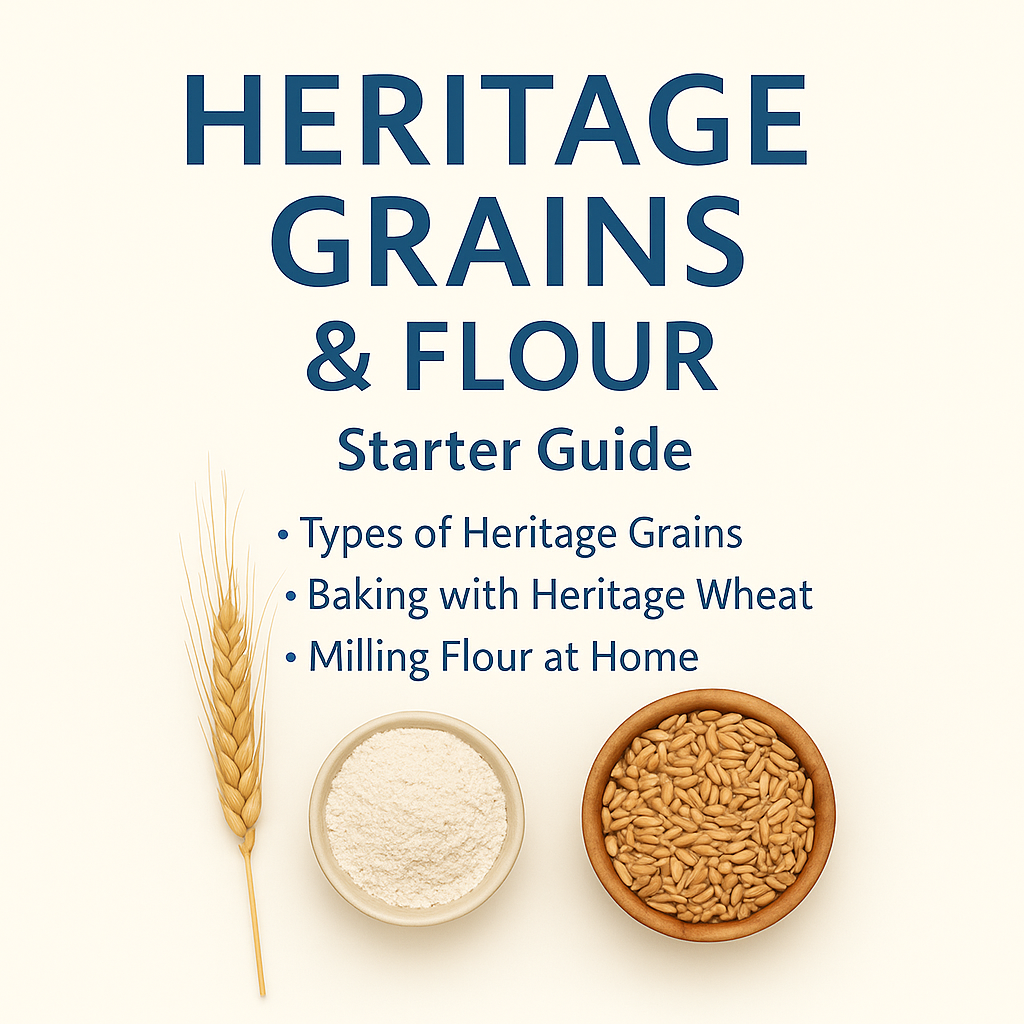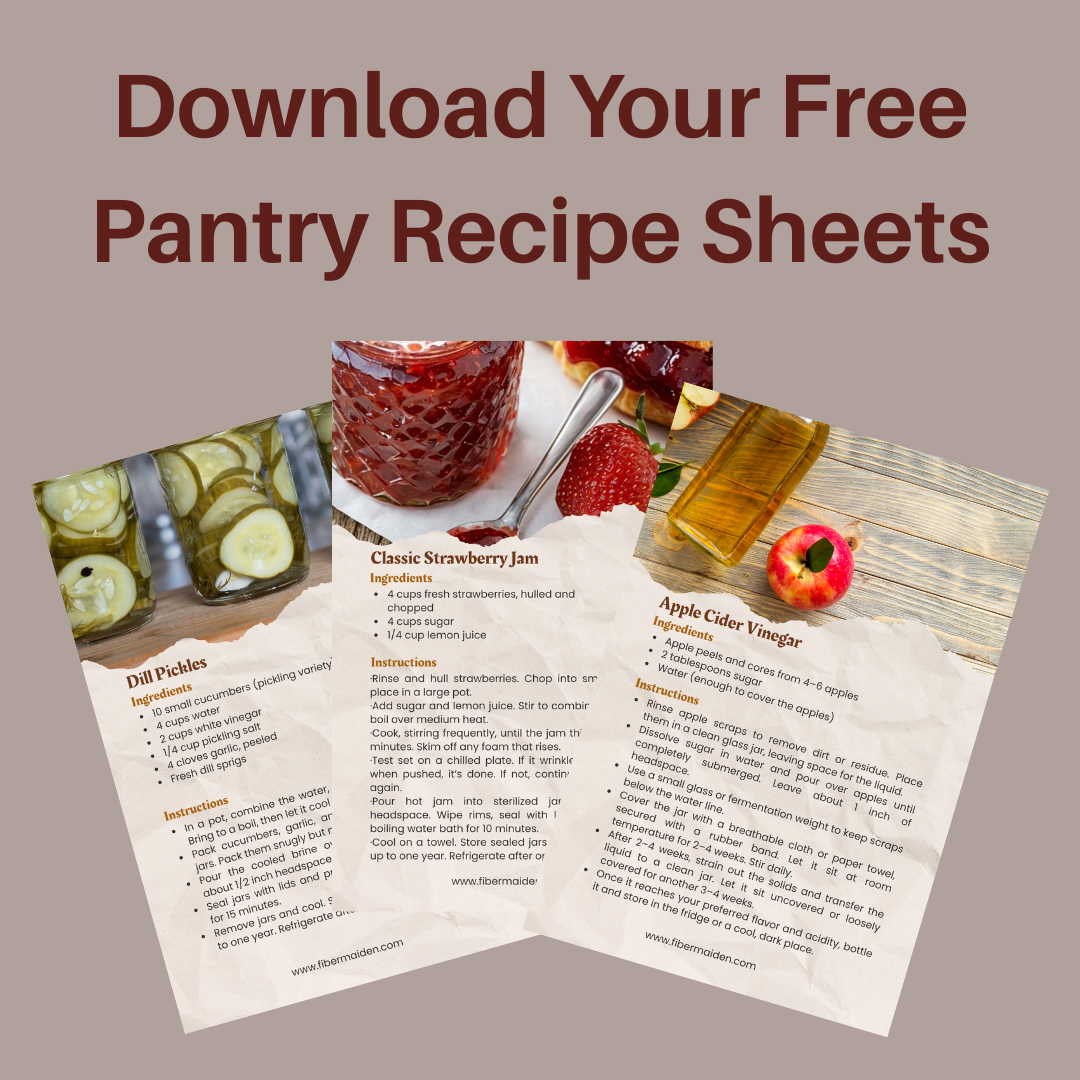Why Fresh-Milled Flour Matters: Flavor, Nutrition, and a Return to Real Food
Why Fresh-Milled Flour Matters: Flavor, Nutrition, and a Return to Real Food
The first time I baked with fresh-milled flour, I couldn't figure out why my kitchen smelled so incredible. Then I tasted the bread and realized I'd been settling for flour that was essentially flavorless cardboard. Fresh-milled flour isn't just flour - it's flavor, aroma, and a connection to what grain is supposed to taste like before it gets processed into shelf-stable powder.
Unlike the bleached, stripped flour found in most grocery stores, fresh-milled flour contains all parts of the grain: bran, germ, and endosperm. This brings nutrition and depth to every bake that transforms ordinary recipes into something you'll actually want to eat again. See the free Grains and Flour printable Quick Guide below.
Get The Guide
Ready to stop wondering what grain to buy or how to use it once you mill it? This guide covers heritage grain selection, storage basics, and beginner-friendly techniques for milling and baking with fresh flour. No more staring at wheat berries wondering what comes next, just clear steps and practical tips so you can actually taste the difference fresh-milled flour makes in your kitchen.
Disclosure
Some links on FiberMaiden are affiliate links. When you click and purchase, I may earn a small commission at no extra cost to you. I partner only with brands and tools I trust and use in my own kitchen, studio, and garden. Your support means a lot.
What Happens When Flour Sits
Here's what nobody tells you about that bag of flour in your pantry: it's been slowly dying since the moment it was milled. As soon as grain is ground, oxidation begins reducing flavor and diminishing nutritional value. Store-bought flour has often been sitting for months, sometimes longer, before it reaches your kitchen.
Fresh-milled flour is different. It's best used within days or weeks, and the difference isn't subtle. You'll notice a richer aroma when mixing and baking, more complex flavors in your breads and muffins, and a satisfying density that actually fills you up. This is flour that still has life in it.
Why Your Body Responds Differently
Many people notice that baked goods made with fresh flour are more filling and don't cause the same blood sugar spikes as regular flour. That's because the bran and germ, rich in fiber, healthy oils, and micronutrients, are still intact doing what they're supposed to do.
Commercial white flour removes these parts to extend shelf life, stripping the grain of most minerals, fiber, and protein. What's left is highly processed starch that your body treats more like sugar than real food.
With fresh-milled flour, you get the full nutritional spectrum the grain was meant to provide, plus the fiber your digestive system needs to process it properly.
Where to Start with Fresh-Milled Flour
Not ready to buy a grain mill but curious about the difference? These three grains are perfect for beginners:
Hard Red Wheat - Rich, nutty flavor that makes bread taste like bread used to. Excellent for anything that needs structure and chew.
Soft White Wheat - Lighter texture and milder flavor. Perfect for muffins, cookies, biscuits, and pancakes where you want tender results.
Einkorn - Ancient wheat with a buttery flavor and impressive nutrient profile. More delicate to work with, but the flavor payoff is worth learning its quirks.
Each grain offers a different baking experience and flavor profiles that make regular all-purpose flour taste like nothing in comparison.
Get 3 Free Recipe Sheets
Ready for recipes that don't require a culinary degree to follow? Get seasonal recipe sheets designed for real kitchens and busy lives, the kind that work even when your kids are asking for snacks mid-prep.
Getting Started Tips
Switching to fresh-milled flour isn't complicated, but it does behave differently. Start by substituting 25-50% of regular flour in familiar recipes to see how it works. Fresh-milled flour absorbs more liquid, so add water or milk gradually until the dough feels right.
Store your flour in the refrigerator or freezer since the oils in the germ can go rancid quickly at room temperature. Expect different textures and sometimes longer rise times, but don't let that discourage you. Once you taste what real flour brings to your baking, going back to the processed stuff feels like settling for less.
The difference fresh-milled flour makes isn't just about nutrition or flavor, though both are remarkable. It's about reconnecting with food that hasn't been optimized for shelf life at the expense of everything else that makes it worth eating.
Grain & Flour Quick Guide
Simple chart and tips for choosing grains, flour types, and blends for fresh milled and store flour.
Best for bread: Hard red or hard white
Best for tender bakes: Soft white
Mild flavor: Hard white • Robust flavor: Hard red
Flatbreads and tortillas: Hard white or a red and white blend
Grain comparison
| Grain | Typical protein | Best for | Flavor notes | Notes |
|---|---|---|---|---|
| Hard Red Wheat | ~12–15% | Yeasted bread, sourdough, pizza, bagels | Nutty, fuller flavor, tan crumb | Strong gluten for rise. Great for 100% whole grain loaves. |
| Hard White Wheat | ~11–14% | Sandwich bread, rolls, tortillas | Mild, slightly sweet, lighter color | Kid friendly flavor with good rise and soft crumb. |
| Soft White Wheat | ~8–10% | Cookies, cakes, muffins, crackers | Delicate, pale crumb | Low gluten. Blend with hard wheat for tall loaves. |
| Einkorn | ~9–12% | Pastry, cookies, quick breads, flatbreads | Buttery, sweet, golden | Weaker gluten. Mix gently. Often lower hydration than modern wheat. |
| Spelt | ~11–15% | Bread blends, pancakes, muffins | Sweet, slightly nutty | Extensible gluten. Handle gently to avoid spread in loaves. |
| Rye | ~7–10% | Rye breads, crackers, blends | Earthy, tangy | Little gluten. Great at 10–40% in blends for flavor and keeping. |
Fresh milled flour tips
- Hydration: plan a bit more water than store flour. Add gradually.
- Autolyse: rest flour and water 20–30 minutes before kneading to soften bran.
- Mixing: shorter knead, more folds. Whole grain tightens if overworked.
- Proofing: whole grain ferments faster. Watch the dough, not the clock.
- Sifting option: sift coarse bran, soak it in a little water, then fold in.
Simple substitutions
- Red and white (hard): swap 1:1. Flavor and color shift slightly.
- Soft white in bread: blend 25–40% soft with hard wheat. Reduce water slightly.
- No bread flour on hand: use hard white or hard red and add a touch more water.
- Einkorn swap: use by itself for cookies and quick bakes or blend 25–50% in bread.
Quick reference
| Use | Best choice | Backup blend |
|---|---|---|
| Everyday sandwich bread | Hard white | 50 50 hard red and hard white |
| Rustic sourdough or pizza | Hard red | 70% hard red + 30% hard white |
| Tender cookies and cakes | Soft white | Soft white + 10–20% hard white |
| Tortillas and flatbreads | Hard white | 60% hard white + 40% soft white |
© FiberMaiden • www.fibermaiden.com









